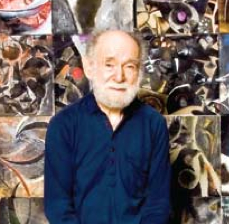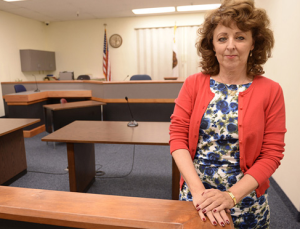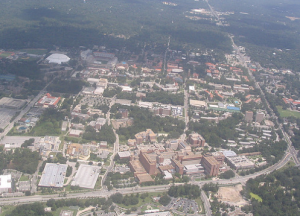News & Announcements
This video includes the entire plenary session from day two of the IIRP’s 16th World Conference on the topic of restorative practices in schools. Dr. John Bailie, IIRP assistant professor and director of continuing education, moderated the panel. The panelists have all overseen restorative practices whole-school change in their respective schools and districts. In order of presentation, they are:
 A piece shown during the "Saving a Place at the Table" art exhibit, from Brattleboro Community Justice Center's web siteBrattleboro Community Justice Center (Vermont, USA) presented two exhibits at the city's monthly art gallery walk to commemorate its 10th anniversary and to recognize restorative justice week, which is celebrated from November 17 to 24 in Canada and other places.
A piece shown during the "Saving a Place at the Table" art exhibit, from Brattleboro Community Justice Center's web siteBrattleboro Community Justice Center (Vermont, USA) presented two exhibits at the city's monthly art gallery walk to commemorate its 10th anniversary and to recognize restorative justice week, which is celebrated from November 17 to 24 in Canada and other places.
Deborah Lee Luskin, for The Commons Online, explains the first exhibit this way:
“Saving a Place at the Table” serves to honor and remember Vermonters who have been victims of violent crime. The exhibit features table-place settings for those killed by criminal violence and those whose lives have been significantly changed by that violence.
 Artist Si Lewen, who donated his work to IIRP, surrounded by some of his paintingsArtist Si Lewen – who celebrates his 95th birthday today – donated his catalog of paintings and rights to his books to the IIRP to support the organization’s mission “to restore and build community in an increasingly disconnected world."
Artist Si Lewen, who donated his work to IIRP, surrounded by some of his paintingsArtist Si Lewen – who celebrates his 95th birthday today – donated his catalog of paintings and rights to his books to the IIRP to support the organization’s mission “to restore and build community in an increasingly disconnected world."
Last month renowned graphic novelist Art Spiegelman featured Lewen's The Parade in a special talk and performance given at Sydney (Australia) Opera House. The Parade: A Story in 55 Drawings, tells the saga of never-ending war as witnessed by Lewen, who watched the armistice parades after World War I morph into the death marches of World War II. Spiegelman is the author of many books including Maus, a two-volume portrayal of his father's experience during the Holocaust for which he was awarded a special Pulitzer prize.
 Julie Hilt, executive director of the Solano County Bar Association (Photo by Joel Rosenbaum for the Vacaville Reporter)The Solano County Bar Association (California), headed by Julie Hilt, executive director, is working to implement a restorative justice program for at-risk youth in the county, and also develop partnerships for building community with schools and others.
Julie Hilt, executive director of the Solano County Bar Association (Photo by Joel Rosenbaum for the Vacaville Reporter)The Solano County Bar Association (California), headed by Julie Hilt, executive director, is working to implement a restorative justice program for at-risk youth in the county, and also develop partnerships for building community with schools and others.
“We’re going to start with kids in diversion from the courts,” said Hilt. Later she hopes to apply for grants so the program can be developed to include adults in the criminal justice system and the jails.
The process of starting the program has involved building relationships and support with all the stakeholders one person at a time.
This video includes the entire plenary session from day one of the IIRP's 16th World Conference on the topic of restorative practices in the criminal justice system. Dr. Craig Adamson, IIRP Assistant Professor and Director of Community Service Foundation / Buxmont Academy, moderated the panel. The panelists were, in order of presentation:
 Aerial photo of University of Florida campus by James Jones (Puggles) at Flickr Creative CommonsBrianna Donet of WUFT, National Public Radio from the University of Florida, reports, "Restorative justice is gaining popularity among college campuses, including at the University of Florida." The report continues:
Aerial photo of University of Florida campus by James Jones (Puggles) at Flickr Creative CommonsBrianna Donet of WUFT, National Public Radio from the University of Florida, reports, "Restorative justice is gaining popularity among college campuses, including at the University of Florida." The report continues:
Restorative justice practices are providing new avenues for describing justice and addressing law violations, Chris Loschiavo, Assistant Dean of Students, and Director of Student Conduct and Conflict Resolution, said. These practices focus on the needs of the victims, the offenders and the community, instead of simply working to punish the offender, he said.
 Photo by Stuart Munro at the Wanganui Chronicle.In Wanganui, New Zealand, a city striving to become a restorative city, a company that "failed to ensure its employees' safety after a toxic leak," according to the court reporter for the Wanganui Chronicle, has pled guilty in court and is now requesting a restorative justice conference between the company and the injured workers. The report states:
Photo by Stuart Munro at the Wanganui Chronicle.In Wanganui, New Zealand, a city striving to become a restorative city, a company that "failed to ensure its employees' safety after a toxic leak," according to the court reporter for the Wanganui Chronicle, has pled guilty in court and is now requesting a restorative justice conference between the company and the injured workers. The report states:
"The leak on November 2 last year saw 21 workers exposed to hydrogen sulphide after a mix-up of chemicals. Two workers were in hospital for a week. ... The section 6 charge carries a maximum fine of $250,000 and judges may, at their discretion, also order emotional harm reparations to be paid.

The 16th IIRP World Conference
October 21-23, 2013 | Bethlehem, Pennsylvania
Pre/post-conference Oct. 19-20 & Oct. 24-25
It's great to see more and more TedX talks tackling issues of restorative practices from a variety of perspectives. Here's a recent talk given by Symeon Brown at TedX Southwark in the UK. According to his bio, "Symeon has worked at the Howard League for Penal Reform with young men and women in custody, founded a grassroots youth project HYPE and was the senior researcher of the Guardian and London School of Economics investigation into the England riots."
Symeon begins his talk by looking at crime in terms of Saturday morning comics (which everyone loves!) but then turns to the topic of "Who are the real bad guys in Britain's jails?" He says that the vast majority are children, mentally ill and people who were formerly in the "carer" or social welfare system.
Susan Leigh Deppe, MD, offered a popular two-part session at IIRP's 16th World Conference on emotion, affect theory and restorative practices. The piece below describes some of the main points of her presentation.
SO THAT’S WHAT’S GOING ON!
UNDERSTANDING EMOTION IN RESTORATIVE PRACTICES
 Communities and schools struggle with behaviors such as crime, bullying, rudeness, and violence. These echo popular culture, where people often act macho and explosive. Actions and attitudes are absorbed out of awareness from the emotional milieu surrounding us, whether family, media, faith community, or schools. Our emotional patterns are sculpted by life experience. People who manage emotion poorly are more likely to be alienated from others or involved in substance abuse, crime and other negative behaviors.
Communities and schools struggle with behaviors such as crime, bullying, rudeness, and violence. These echo popular culture, where people often act macho and explosive. Actions and attitudes are absorbed out of awareness from the emotional milieu surrounding us, whether family, media, faith community, or schools. Our emotional patterns are sculpted by life experience. People who manage emotion poorly are more likely to be alienated from others or involved in substance abuse, crime and other negative behaviors.
